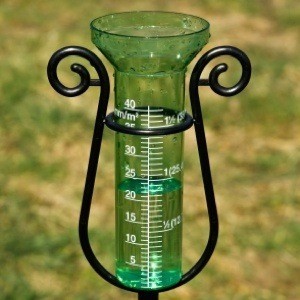
Weather can play a dramatic role in the success or failure of your garden. It impacts plants' need for food and water, their ability to flower and produce fruit, and their resistance to attacks by insects and disease. One of the most enjoyable and accurate ways to observe the weather is to create your own garden weather station. How elaborate you choose to build it depends on your level of interest and your budget.
Long before meteorologists had sophisticated tools to help predict the weather, farmers and gardeners relied on observing signs from nature to forecast the weather. Today, despite incredible advancements in technology, accurately predicting the weather still remains part science and part good old-fashioned luck. Here is a list of suggested weather instruments to consider when creating your weather station:
Anemometer (wind speed): Mechanical anemometers are typically made up of several large "cups" that spin like a helicopter blade when they catch the wind. The spinning generates magnetic impulses inside the unit that are then converted into a precise wind speed by an electronic circuit. Measuring wind speed can help you when choosing a site for plants and alert you to the potential for increased moisture loss.
Barometer (air pressure): Changes in air pressure bring on changes in weather. High pressure areas bring clear skies and fair weather; low pressure areas bring wet or stormy weather. Areas of very low pressure tend to indicate serious storms, such as hurricanes.
Hygrometer/psychrometer (relative humidity): Relative humidity is the amount of water vapor present in the air at a specific temperature compared to the maximum amount of water vapor that the specific temperature is able to hold before water condenses (the point it condenses is called the Dew Point). Humidity indicates the likelihood of precipitation, dew, or fog. High humidity reduces the rate of moisture lost through evaporation and creates ideal conditions for mold and fungal diseases.
Rain gauge (precipitation): A rain gauge should be placed in an area that is exposed to an open sky, unless you are trying to track the precipitation received by plants under overhanging trees. In general, most vegetables and ornamental plants need 1 inch of water a week during the growing season through a combination of rainfall and/or supplemental irrigation.
Thermometer (measures air temperature): For an accurate reading, make sure that the bulb of your thermometer is protected from direct sunlight.
Wind/weather vane( wind direction): Weather vanes spin on a rod and point in the direction the wind is coming from. Because they are available in a variety of designs, they are both are practical and fun at the same time, and a great way to add functional art to your garden. Locate your weather vane in an open area where it can rotate freely as the wind direction changes.
A weather journal: By recording all of your observations and data in a notebook, you can calculate weekly, monthly, and yearly averages for temperature , precipitation, etc. This will give you a sense of overall weather patterns that affect your garden from season to season, and provide you with useful information when it comes to selecting plant varieties and starting seeds.
Probably the easiest and most convenient way to observe weather conditions in your garden is by using a comprehensive all-in-one wireless weather station. Equipped with remote wireless sensors that you set in various places in your garden, real time data is transmitted to a display in the house, much like a wireless telephone does. This allows you to observe conditions all year long from the comfort of indoors. The disadvantage to the all-in-one units is the price-anywhere from fifty to several hundred dollars or more. The advantage is the convenience and the comprehensive readings you can get all from one device:
The microclimate of your garden-the small climate created by the presence of things like hills, trees, and nearby buildings-also influences how weather affects your plants. Where you locate your weather instruments can affect the accuracy of the data you collect as it relates to your garden. To make sure you get the most accurate readings possible, it is important to take readings from locations relevant to your plants. For example, let's say you have a rose bush planted next to your house and you're worried about the potential for powdery mildew. Recording the humidity next to your house will give you more accurate data than taking readings from the middle of your vegetable garden.

About The Author: Ellen Brown is an environmental writer and photographer and the owner of Sustainable Media, an environmental media company that specializes in helping businesses and organizations promote eco-friendly products and services. Contact her on the web at http://www.sustainable-media.com
Add your voice! Click below to comment. ThriftyFun is powered by your wisdom!
Great ideas. A rain gauge could help me with gardening, as I sometimes tend to over water!
This is a good idea, and it is great for kids to learn, I like the Redneck Weather Station, where you tie a string to a piece of wood and paint on it or write on it:
If string is wet, it is raining,
If string is dry it is not raining.
If string is moving the wind of blowing.
There were some more things but this was so funny to me. I do love teaching kids about the weather though. :)
Add your voice! Click below to comment. ThriftyFun is powered by your wisdom!